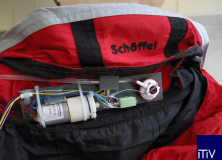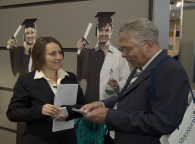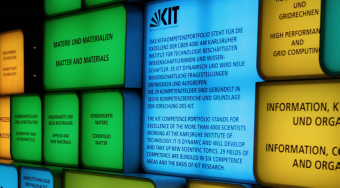At this year’s exhibition in Hannover, the Karlsruhe Institute of Technology (KIT) represents itself on a central and several other theme stands. The newly formed KIT centers, Energy and Elementary Particle and Astroparticle Physics, as well as KIT’s focus Networked Adaptive Systems, are presenting examples from their current research on the main stand. Also, the Alumni network of the university and the KIT business club are granting insights into their work.
Hall 2, Stand C18: Karlsruhe Institute of Technology
Topic: Energy
- KIT Center Energy: With its 1100 employees the center is one of the largest energy research institutions in Europe. It combines the energy research at the Universität and the Forschungszentrum Karlsruhe as well as well-known partners. The exhibit gives an overview of the work areas of the KIT Center. These are: energy conversion, renewable energies (biomass, geothermal energy, renewable hydrogen), energy storage and distribution, efficient energy use, fusion technology, nuclear energy and safety as well as energy systems analysis.
- Quench exhibit: These cooling experiments study the safety of nuclear reactors. The Quench group deals with research on high-temperature behaviour and hydrogen production when quenching an overheated and partially destroyed reactor core. For this purpose test bundles are electrically heated up to 2000 degrees, then rapidly cooled with either water or steam - a protective measure for temperature reduction in the reactor. You can see a model with nuclear fuel rods.

Cooling experiments in the Quench research laboratory
Photo: Forschungszentrum Karlsruhe
- Levitation model exhibit: This exhibit demonstrates the application of high-temperature superconductors in low-loss bearings of motors, generators and flywheel energy storage. Researchers at KIT develop innovative components for the energy technology using the latest materials science from high-temperature superconductors. The focus is on development, construction and testing of superconducting energy storage, current limiters, transformers and magnetic systems. Superconducting energy storage and current limiters are used in the public energy supply and industrial networks. Superconducting magnet systems and power supply lines are used in the magnetic resonance imaging, nuclear magnetic resonance spectroscopy and for large magnets of fusion reactors.
Topic: Elementary Particle and Astroparticle Physics
- KIT center Elementary Particle and Astroparticle Physics: How big is the mass of a neutrino and what is its role in the formation of the universe? What is dark matter? Where does the high energy cosmic ray originate from and what are its particles? The Center of Elementary Particle and Astroparticle Physics is concerned with these questions about the fundamental building blocks of matter and their interactions in the laboratory and the universe.
- Pierre Auger Observatory exhibit: particles of cosmic radiation produce gigantic cascades when entering the Earth's atmosphere. The Pierre Auger Observatory in the Argentine pampas is the world’s largest measuring field to study cosmic radiation. 1600 detectors on an area of 3000 square kilometres measure the most energetic atomic nuclei that can be found in the universe. Four telescope stations pursue the light traces. The simulation of particle showers on the Auger site can be seen at the exhibition stand..

Pierre-Auger-Observatory in Argentina
Photo: Forschungszentrum Karlsruhe
Topic: Networked Adaptive Systems
- KIT Networked Adaptive Systems: The focus of the research is on concepts and methods for a secure and self organised interaction and cooperation of adaptive networked systems and services. The reliable functioning of these systems is the key to the development of innovative applications for business and society. Interdisciplinary research groups of five subjects investigate, in a variety of projects, the technical, legal and economic issues. The topics are algorithm and software engineering, grid and scientific computing, systems engineering, communication, eOrganisation and service engineering.
- Intelligent technical textiles exhibit: There is shown a skiing jacket with climate control. It compensates extreme fluctuations in temperature during physical exertion due to rapid descent and sitting in the cold wind on the elevator. The principle of operation is that the insulation can be changed through integrated inflatable air chambers. Furthermore, an automatic climate control can be facilitated by active heating and cooling. The jacket can also make a significant contribution to reducing CO2- as only persons are heated or cooled, and not the entire home. The cooling can save energy up to a factor of 1000.

Intelligent materials: it cools down or warms up depending on temperature.
Photo: ITIV
- Electronic voting system exhibit: This electronic electoral procedure provides verifiability of the election result, in contrast to the traditional voting machine. The voter can check with his receipt the correct counting of his vote, without showing what was elected. This prevents buying of votes and extortion.
AlumniKaTH, Career Service and Fundraising
The alumni network of the Universität Karlsruhe, called AlumniKaTH, has 14 000 members worldwide. Former students of Fridericiana can make contact worldwide and make use of advanced education offerings. The Career Service is the interface between students and companies to assist in the search for traineeships and first time employment. The fundraising and foundation division offers patrons of the University models for their commitment.

Stay in contact with Alma Mater: AlumnikaTH has a worldwide alumni network.
Photo: AlumnikaTH
KIT Business Club
The KIT Business Club combines the diverse industry contacts of KIT. It communicates to all the companies, individuals and investors, who are interested in the technology developments in KIT and want to commit themselves strategically.
Furthermore, the KIT is represented with the following topics:
- Hall 2, Stand D46: Biomechanics following the example of the trees.
- Hall 2, Stand D48: Superconductivity in energy technology.
- Hall 2, Stand E27: Piezoelectric transducer as a sensor and actuator.
- Hall 13, stand G70/1: hydrogen technology - production from biomass, storage, transport, fuel cell and material research.
- Hall 26, stand J01-3: Career Service of the Karlsruhe Institute of Technology.
- Hall 27, stand E41/1: bioliq - Procedures for obtaining fuel from biological residue.
The Karlsruhe Institute of Technology (KIT) represents the merger of the Universität Karlsruhe with the Forschungszentrum Karlsruhe. Altogether, it has 8000 employees and an annual budget of 700 million Euros.
The KIT will be an institution of internationally excellent research and teaching in natural and engineering sciences. KIT shall attract the best experts from all over the world, set new standards in teaching and promotion of young scientists, and establish the leading European center in the field of energy research. KIT will assume a leading role in nanosciences worldwide. It is the objective of KIT to be one of the most important cooperation partners of industry.

